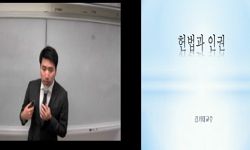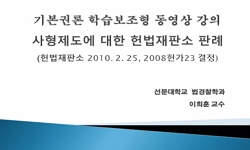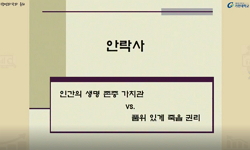The Supreme Court of Korea ruled in 2009 that if a patient was in an irreversible condition with imminent death, withdrawing life-sustaining treatments was approved as his or her self-determination. After this approval, the necessity of the legislatio...
http://chineseinput.net/에서 pinyin(병음)방식으로 중국어를 변환할 수 있습니다.
변환된 중국어를 복사하여 사용하시면 됩니다.
- 中文 을 입력하시려면 zhongwen을 입력하시고 space를누르시면됩니다.
- 北京 을 입력하시려면 beijing을 입력하시고 space를 누르시면 됩니다.
연명치료중단의 허용요건에 관한 법적 쟁점과 과제
한글로보기https://www.riss.kr/link?id=G3747679
- 저자
-
발행기관
-
-
발행연도
2016년
-
작성언어
Korean
- 주제어
-
자료형태
한국연구재단(NRF)
-
0
상세조회 -
0
다운로드
부가정보
다국어 초록 (Multilingual Abstract)
The Supreme Court of Korea ruled in 2009 that if a patient was in an irreversible condition with imminent death, withdrawing life-sustaining treatments was approved as his or her self-determination. After this approval, the necessity of the legislation regarding to withdrawing life-sustaining treatments or ‘death with dignity’ was actively discussed and several bills were proposed in the National Assembly.
Since the concept of withdrawing life-sustaining treatments is similarly used with concepts of ‘death with dignity’ or euthanasia, people become confused and it is difficult to establish legal guidelines or instructions.
Thus the current situation demands to unify concepts relating to withdrawing life-sustaining treatments. In designing the legislation relating to withdrawing life-sustaining treatments, the following points should be defined. First, the decision of a terminal patient should establish a medical standard with an accurate procedure. Second, it is necessary to establish a legal standard of the right to agree from a substitute as well as providing a legitimacy to an patient’s declaration of intention. It is also necessary to give a chance to her intention, preparing for the case that the patient might fall into unconsciousness and withdrawing life-sustaining treatme
국문 초록 (Abstract)
의료기술의 발전을 통하여 말기환자들에게 생명연장이 가능하게 되었다는 점에서는 큰 의미를 부여할 수 있으나, 연명치료를 통하여 환자들이 받게 되는 육체적ㆍ정신적인 고통은 생명연...
의료기술의 발전을 통하여 말기환자들에게 생명연장이 가능하게 되었다는 점에서는 큰 의미를 부여할 수 있으나, 연명치료를 통하여 환자들이 받게 되는 육체적ㆍ정신적인 고통은 생명연장의 기쁨보다 인간의 존엄성까지 상실시킬 수 있다는 문제가 제기되었다. 또한 2009년 대법원 전원합의체 판결을 통해서 생명의 불이 꺼져가는 말기환자의 무의미한 연명치료를 중단시킬 수 있는 중대한 결정을 내림으로써 국민들의 이목을 집중시켰을 뿐만 아니라 연명치료중단의 허용기준에 관한 논쟁을 불러일으켰다. 안락사의 허용여부에 관한 논쟁은 그 역사가 길며, 지금도 세계 각국에서 안락사 허용 여부를 놓고 열띤 논쟁을 벌이고 있다. 안락사 찬성론자들과 반대론자들의 주장이 팽팽히 맞서고 있는 상황에서 어떠한 경우를 안락사라고 말하고 어느 범위 또는 유형의 안락사가 현행법상 허용될 수 있는 ‘존엄사’인가에 대해서는 견해가 일치하지 않고 있다.
따라서 본 연구에서는 ‘무의미한 연명치료중단’으로서의 존엄사의 개념과 안락사의 유형 및 법적 쟁점을 검토하고, 존엄사의 입법화에 대한 우리사회에서 이를 어떻게 정당화시켜 나갈 것인지에 대한 방향제시를 하고자 한다.









